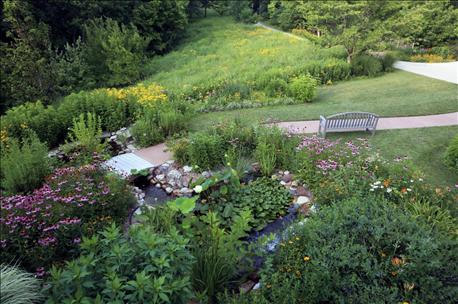May 19, 2016

Now would be a great time to reduce your turf grass footprint and add native plants to your yard.
Perhaps you need to extend a shady flowerbed to encompass a tree trunk for easier mowing. Purple coneflower (Echinacea purpurea), star tickseed, (Coreopsis pubescens), and palm sedge (Carex muskingumensis) work well in part shade.
Low, wet areas are also difficult to mow, so why not plant them with native wet-loving perennials like marsh milkweed (Asclepias incarnata), orange coneflower (Rudbeckia fulgida var. umbrosa), and fox sedge (Carex vulpinoidea).
Create a new garden shape

CREATE SHAPE: Scott Woodbury lays an ordinary garden hose to create a shape for his garden. He will then mark the area and plant his native garden to add visual appeal.
Have you wanted to "unsquare" your yard? Lay a garden hose down on the lawn to shape new or existing planting beds. Leave the hose out for several days and play with various curves until you are satisfied.
When you are happy with the new design, you can remove the grass many ways. Dig it up with a sharp, straightedge shovel, rent a sod-cutter, solarize with plastic, or carefully spray with an herbicide like glyphosate. It's your choice, but do remember to not bite off more than you can chew.
If you have gaps in an existing sunny flowerbed, native annuals like Helen's flower (Helenium amarum), red whiskers (Polanisia dodecadra), or palafox (Palafoxia callosa) may do the trick. These plants also have long bloom times and a candy-apple attraction to pollinators.

BRINGING IN NATURE: Planting a variety of native plants attracts birds, bees and butterflies to the garden.
Many of the plants in our neighborhoods are attractive to humans, but not to insects and many other beneficial creatures. For instance, Annabelle and blue hydrangeas, daylily, and hosta come to mind. Why not replace a few each year with similar natives such as wild hydrangea (Hydrangea arborescens), copper iris (Iris fulva) and little-flower alumroot (Heuchera puberula)? I guarantee that this will create movement in your garden. Here's why.
Changing the landscape
Doug Tallamy, author of Bringing Nature Home, writes that in the lower 48 United States there aren't many places left that can support wildlife. Farmland is locked into plantings of corn, soybean, cotton, artichoke, citrus, timber, or cattle, depending on where you live.
Original, undeveloped habitats (about 5%) will remain intact with support for conservation efforts—but more land to sustain and increase native biodiversity is needed.
Developed land (about 55%) is what remains. This is where we live, work, play, worship, shop, learn, and are laid to rest. This is the only part of our country where significant change can still happen, and it is happening big-time right now--a place where birds, bees, amphibians, and butterflies are moving in gardens full of native plants.
Native gardeners find monarchs laying eggs on marsh milkweed. They find birds nesting in rusty blackhaw viburnum (Viburnum rufidulum). They even get tadpoles in small urban water gardens planted with pickerelweed (Pontederia cordata), arrow alum, (Peltandra virginica) or fragrant water lily (Nymphaea odorata).
The saying "plant native and they will come" has never been more important. About half of our migrating birds are in steep decline. Monarch butterflies and a host of other butterfly and bee species are in trouble also. Those are reasons why native plants are flying off the shelves in garden centers. In addition, they are beautiful and adapted through time to thrive in our region. So what are you waiting for? Go native!
Horticulturist Scott Woodbury is the Curator of the Whitmire Wildflower Garden at Shaw Nature Reserve, where he has worked with native plant propagation, design, and education for more than 20 years. He also is an advisor to the Missouri Prairie Foundation's Grow Native! program.
You May Also Like




